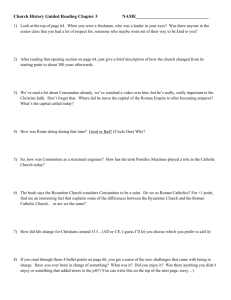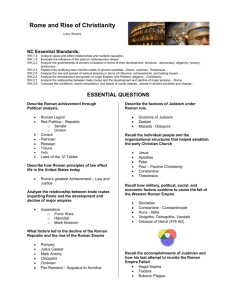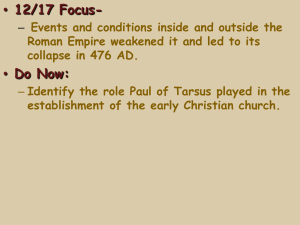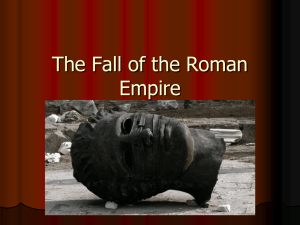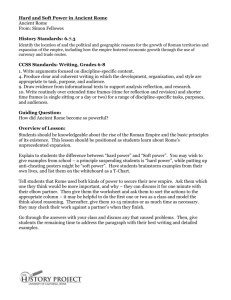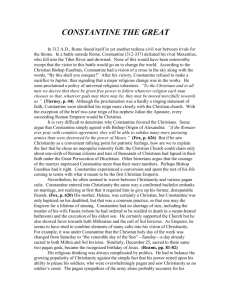Circumstances That Influenced the Early Church
advertisement
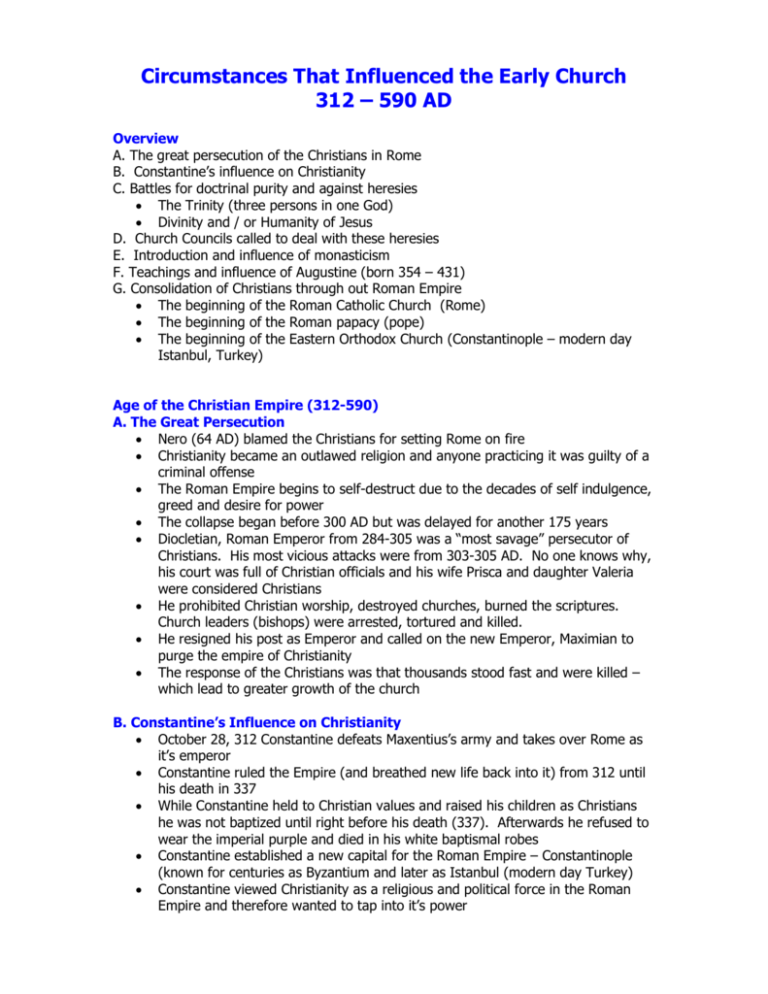
Circumstances That Influenced the Early Church 312 – 590 AD Overview A. The great persecution of the Christians in Rome B. Constantine’s influence on Christianity C. Battles for doctrinal purity and against heresies The Trinity (three persons in one God) Divinity and / or Humanity of Jesus D. Church Councils called to deal with these heresies E. Introduction and influence of monasticism F. Teachings and influence of Augustine (born 354 – 431) G. Consolidation of Christians through out Roman Empire The beginning of the Roman Catholic Church (Rome) The beginning of the Roman papacy (pope) The beginning of the Eastern Orthodox Church (Constantinople – modern day Istanbul, Turkey) Age of the Christian Empire (312-590) A. The Great Persecution Nero (64 AD) blamed the Christians for setting Rome on fire Christianity became an outlawed religion and anyone practicing it was guilty of a criminal offense The Roman Empire begins to self-destruct due to the decades of self indulgence, greed and desire for power The collapse began before 300 AD but was delayed for another 175 years Diocletian, Roman Emperor from 284-305 was a “most savage” persecutor of Christians. His most vicious attacks were from 303-305 AD. No one knows why, his court was full of Christian officials and his wife Prisca and daughter Valeria were considered Christians He prohibited Christian worship, destroyed churches, burned the scriptures. Church leaders (bishops) were arrested, tortured and killed. He resigned his post as Emperor and called on the new Emperor, Maximian to purge the empire of Christianity The response of the Christians was that thousands stood fast and were killed – which lead to greater growth of the church B. Constantine’s Influence on Christianity October 28, 312 Constantine defeats Maxentius’s army and takes over Rome as it’s emperor Constantine ruled the Empire (and breathed new life back into it) from 312 until his death in 337 While Constantine held to Christian values and raised his children as Christians he was not baptized until right before his death (337). Afterwards he refused to wear the imperial purple and died in his white baptismal robes Constantine established a new capital for the Roman Empire – Constantinople (known for centuries as Byzantium and later as Istanbul (modern day Turkey) Constantine viewed Christianity as a religious and political force in the Roman Empire and therefore wanted to tap into it’s power A church historian, Eusebius, envisioned this era and a new age of salvation. Being able to publicly preach proved divine approval for the change of events in the Empire “Prior to Constantine’s conversion, the church consisted of convinced believers. Now many came who were politically ambitious, religiously disinterested, and still half-rooted in paganism. This threatened to produce not only shallowness and permeation by pagan superstitions but also the secularization and misuse of religion for political purposes.” (pg. 96) By 380 non-Christians were being persecuted for not being Christians Emperor Theodosius made belief in Christianity a matter of imperial command Church buildings designed to emphasize the new hierarchy of Christ and emperor Due to a riot by people in Thessalonica (390) [because a favorite charioteer was accused of homosexuality and imprisoned] the emperor had 7,000 Thessalonians killed Ambrose, the Bishop of Milan, refused the emperor communion until he confessed his sins and later threatened him with excommunication (expulsion from the church and therefore sentenced to hell). Excommunication became a powerful tool for the church leadership to use against the secular rulers C. Battles of Doctrinal Purity 1. The Trinity (Three persons in one God) With the years of persecution behind them the Christians turned to solve doctrinal issues and disagreements No other religion worships a three-in-one deity. How do they explain it? Those who survived the religious persecution wanted doctrinal purity and if some differed they called for them to be suppressed or banished from their churches by the power of the state Arianism (named after Arius, pastor of the Baucalis Church) taught that “the Word (Logos) who assumed flesh in Jesus (John 1:14) was not the true God and that he had and entirely different nature…” (pg. 100) Constantine stepped in to settle the dispute and in 325 he called for a council in Nicea. Over 300 bishops attended and Constantine called them to “come to some agreement on the questions that divided them. Division in the church, he said, was worse than war.” (Pg. 101) The debate was settled (against Arianism) and a creed was written (Nicene Creed) which is still used today in the Roman Catholic Church After the Nicene Council Constantine and other government officials would step in to settle disputed matters. Often times the church leaders were exiled. Some would later return from exile as a new government official, sympathetic to their position, replace the old government official For centuries the Trinity was a source of debate among the scholars and still is today 2. The Divinity and / or Humanity of Jesus The theology of “Who is Jesus? Is known as Christology (the study of Christ) The issue of Incarnation (God-man) – became central to Christian worship before it became central to Christian thinking The Event (Incarnation – Jesus being both God and man) was debated for generations because much was at stake (spiritual, religious, political) 2 These heresies continued to flourish from 350-450 and the church needed greater clarity Additional heresies included: The question of Mary. Is she the “Mother of God” of the “God bearer”? D. Church Councils Called to Deal with Heresies In order to settle matters and establish uniform teaching a church structure began to take form (with the governments approval and influence) a. Bishops in chief towns in imperial provinces came to be called Archbishops. b. The term for the geographical area they had responsibility for were known as a See c. Bishops in the premier cities of the empire – Rome, Constantinople, Alexandria and Antioch – were considered the highest of all bishops and were called Patriarchs d. Throughout the 4th and 5th centuries these Patriarchs tried to expand the geographical area of their influence and authority Major Church Councils Council of Nicea (325) Result: Christ is fully divine Council of Constantinople (381) Result: Christ is fully human Council of Ephesus (431) Result: Christ is a unified person Council of Chalcedon (451) Result: Christ is human and divine in one person E. Introduction and influence of monasticism “The model Christian was no longer the courageous bishop dragged before wild beasts in a Roman arena. He was now was a lonely hermit in the forsaken Egyptian desert defying the devil.” (pg. 116) Monasticism (exiling oneself from life – living like a hermit or monk) was a response to dealing the battles of the flesh. (The Reformation Movement – 1,600s – struck a blow to monasticism claiming it set up a standard of a higher and lower morality) Around 140 a writing appeared call “The Shepherd of Hermas” offering advice for those who wish to do more than what is required of the “ordinary” Christian. Suggestions like greater self-denial (celibacy, no possessions, Monasticism was a response to Constantine’s influence resulting in a decline in Christian commitment. “Once Christians had laid down their lives for the truth; now they slaughtered each other to secure the prizes of the church.” (pg. 118) Living on their own to avoid temptations found new temptations – pride, rivalry and eccentricity In 320 a former soldier Pachomius instituted the first Christian monastery. Life was strictly regulated between worship, working, studying and meals The goal was to only exist for God and to live from his grace alone. Monks took a vow of poverty, chastity and obedience Others who influenced monastery life were Jerome (340-420) and Benedict (died in 542) The monastic life-style had been criticized as unnatural. “To enter a monastery was to separate from the world, to abandon the ordinary relationships of social life.’, to shun marriage and all the Christian home signifies.” (pg. 123) 3 F. Teachings and influence of Augustine (born 354 – 431) To this day Christians and Catholics feel the influence of Aurelius Augustinus (Augustine), Bishop of Hippo. Roman Catholics draw much of their doctrine from Augustine’s teachings Born November 13, 354 in Tagaste, known today as Algeria. His mother was a devout Christian, his father an easy going heathen He went to school in Carthage and found sexual temptations irresistible. He fell in love with a girl who gave him a son, Adeodatus At the age of 19, after reading a treatise by Cicero, he decided to make the quest of truth his ambition He followed the teachings of Manichean from 374 - 383 until he became dissatisfied He picked up a New Testament and began reading it. He was baptized in 387, along with his son and a friend, Alypius in Milan In 388 his son died In 391, at Hippo, by popular demand but against his will Augustine was ordained a priest. A short time later he became an assistant bishop. A year later, at the age of 43, he became Bishop of Hippo, where he served the next 33 years When he became bishop he faced a movement called Donatism – which protested against Catholic practices, namely the authority of certain bishops and priests appointed by them who destroyed scriptures Augustine argued that the church would be made up of a mixed multitude and supported his view using Matt. 13:24-30 (not recognizing Jesus was talking about the world) He raised the profile and authority of the priests. He argued that priests acts are really God’s acts because he gave them their authority. Therefore, the priest was a channel for grace from God to the members of the church His defense against the Donatiist controversy supported the use of force in the suppression of his rivals. “Thus, Augustine’s prestige was made available for those in later ages who justified the ruthless acts of the Inquisition against Christian dissenters.” (pg. 128) In 419 the Pelagians (followers of Pelagius) were banished by Emperor Honorius. Why? Because they denied that human sin is inherited from Adam. (pg 129) In Augustine’s view Adam’s sin had enormous consequences and was passed down to every man (Original Sin Concept) Augustine also bound God’s grace to only those who were members of the Catholic Church. Therefore if one was excommunicated or left the church he was cut off from God’s saving grace Augustine considered the church as the only human community and that the secular governments, founded on the sinfulness of man must submit to the laws of the Christian church He wrote; “The City of God” which provided a spiritual interpretation of suffering – things might be bad now but in the future they will be much better Augustine died on August 28, 430 4 G. Consolidation of Christians through out Roman Empire 1. Structuring of the Roman Catholic Church Bishop Leo of Rome saved Rome from sure destruction from Attila the Hun in 452. Afterwards he became famous and revered. He assumed a new role and staked a fresh claim on the future of the Catholic church He slowly consolidated power and introduced the theology of the Papacy The word “pope”, originally expressed as “papa” (showing the shepherding care given by the bishops to their flock) didn’t become reserved for the Bishop of Rome until the 6th century (506) Early Christian writers (beginning with Irenaeus in the 2nd century) referred to Peter and Paul as the founders of the church in Rome and as subsequent bishops as successors of the apostles. “Many catholic Christians felt that a list of bishops traced back to Peter and Paul was a sure means of safeguarding the apoplectic message.” (pg. 134) As the church grew and the threats increased there became a need for some form of organizational structure. It developed in two ways: 1. The authority of the church councils and 2. The authority of certain bishops over other bishops “As the church grew it adopted, quite naturally, the structure of the empire.” (pg. 134) As the empire was divided into four regions, so the church began to function as four regions: Rome, Carthage, Alexandria and Antioch From these four major centers smaller congregations were started in the countryside Surely, due to Rome’s stature, the Bishop of Rome grew in stature, power and authority Leo, Bishop of Rome makes his appeal for a Supreme Head of all Christendom. Using Matt. 16:13; Luke 22:31-32 and John 21:15-17 he lays out a biblical foundation for the Papacy On October 30, 451 the council of Chalcedon gave the Bishop of Constantinople the same authority as that of Leo This represents the beginning of the split of the Roman Catholic Church into the Roman Catholic Church in the West and the Eastern Orthodox Church in the East 2. Split between Roman Catholic Church and Eastern Orthodox Church Today the Eastern Orthodoxy is that when man sins he doesn’t separate himself from God but rather reduces his divine likeness Christ came to restore the likeness (icon) of God in man Icons play a large part in their faith 5



